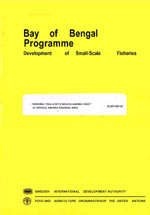
WORKING PAPERS - BOBP/WP/56
Fishing Trails With Beachlanding Craft At Uppada, Andhra Pradesh, India
by
by L. Nyberg
Fishing Technologist (Associate Professional Officer)
Bay of Bengal Programme
 |
WORKING PAPERS - BOBP/WP/56 Fishing Trails With Beachlanding Craft At Uppada, Andhra Pradesh, Indiaby |
|
Executing Agency: FOOD AND AGRICULTURE ORGANIZATION OF THE UNITED NATIONS Funding Agency: SWEDISH INTERNATIONAL DEVELOPMENT AUTHORITY Development of Small-Scale Fisheries in the Bay of Bengal. Madras, India, June 1987 |
| The designations employed and the presentation of material in this publication do not imply the expression of any opinion whatsoever on the part of the Food and Agriculture Organization of the United Nations concerning the legal status of any country, territory, city or area or of its authorities, or concerning the delimitation of its frontiers or boundaries. |
All rights reserved. Reproduction and dissemination of material in this information product for educational or other non-commercial purposes are authorized without any prior written permission from the copyright holders provided the source is fully acknowledged. Reproduction of material in this information product for resale or other commercial purposes is prohibited without written permission of the copyright holders. Applications for such permission should be addressed to the Chief, Publishing and Multimedia Service, Information Division, FAO, Viale delle Terme di Caracalla, 00100 Rome, Italy or by email to [email protected]
© FAO 2004
|
This paper discusses the conduct and findings of fishing trials carried out with the BOBP beachcraft IND 20-C at Uppada, Andhra Pradesh, India between August 1985 and July 1986. The beachcraft was equipped with fishing gear designed to catch large pelagic species. The idea was to investigate the craft’s fishing potential in offshore areas — since earlier fishing trials had been confined to inshore waters. The trials were conducted at the request of the Directorate of Fisheries and in cooperation with them. Five private fishermen constituted the crew. An inspector of fisheries was the main local counterpart. On behalf of BOBP, a fishing technologist (associate professional officer) provided the expertise, while a senior fishing technologist and a naval architect consultant provided supervision and advice as necessary. The trials showed that the BOBP beachcraft are capable of fishing in offshore waters up to 35 n miles. Catch performance and profitability can be improved with better organization and refinements to the craft’s propulsion unit. The fishing trials, and this paper which reports on them, were sponsored by the small-scale fisheries project of the Bay of Bengal Programme (BOBP) during its first phase (1979 - 86). During this phase the project was funded by SIDA (Swedish International Development Authority) and executed by the FAO (Food and Agriculture Organization of the United Nations). Its objective was to develop, demonstrate and promote methodologies and technologies to improve the conditions of small-scale fisherfolk in five member countries - Bangladesh, India, Malaysia, Sri Lanka and Thailand. |
1. INTRODUCTION
2. CONDUCT OF THE FISHING TRIALS
3. FINDINGS
4. CONCLUSIONS AND RECOMMENDATIONS
PUBLICATIONS OF THE BAY OF BENGAL PROGRAMME